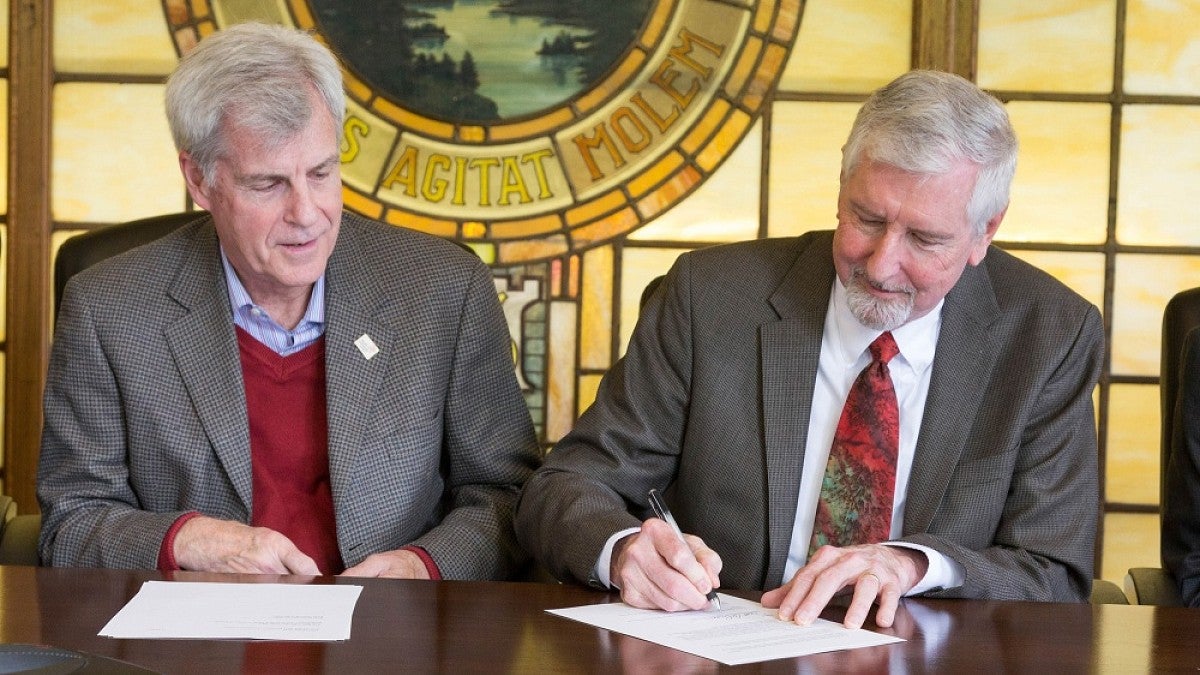The complicated process of applying to pharmacy school just got a bit easier for UO undergraduates, thanks to a newly signed partnership agreement between the University of Oregon and Pacific University.
Called the UO-Pacific Bridge Program, the new option will provide a pipeline for UO undergraduates pursuing careers as pharmacists, said Ian McNeely, associate dean of undergraduate education and a professor in the Department of History. The agreement provides a means for UO undergraduates to pursue guaranteed admission interviews for Pacific’s three-year program toward a doctor of pharmacy degree, known as a PharmD, at Pacific’s Hillsboro campus.
“For any student who shows an interest in pharmacy, we can point them to this great opportunity waiting for them right up the road,” McNeely said.
A private university with around 3,600 students, Pacific is one of two Oregon universities offering a PharmD program — Oregon State University’s College of Pharmacy offers another option. Pacific University’s pharmacy program features tracks devoted to clinical pharmacy, precision medicine, underserved populations and other areas of specialty.
The UO-Pacific Bridge Program agreement was finalized during a recent Johnson Hall signing ceremony attended by UO Provost Scott Coltrane, Pacific University Provost John Miller and other representatives from both institutions. Pacific University officials are initially targeting 10 to 15 students per application period, said David Fuentes, assistant dean for academics and assessment and a professor in the School of Pharmacy.
“It formalizes a fantastic union between the University of Oregon and Pacific University, starting with our School of Pharmacy, and focusing on the University of Oregon’s talented undergraduate students,” Fuentes said. “We hope this agreement builds a strong foundation for future collaborations and innovative program offerings to help attract, retain and develop the best students in Oregon, the Northwest and beyond.”
The bridge program is open to undergraduate students who have completed 60 quarter credit hours, including the required core courses, and met minimum GPA and grade requirements. Once accepted, students must maintain a minimum GPA of 3.0, meet annually with a Pacific administrator, receive mentorship and advice from faculty members and current students, complete self-assessments and fulfill other requirements designed to prepare students for the formal application process. Students who apply to the Pacific PharmD program are then guaranteed an interview.
In developing the UO-Pacific Bridge Program, McNeely worked closely with UO health professions advisors. The application process for pharmacy school is extensive, competitive and time-consuming, said advisor Megan Weiler. The bridge program will assist students in that process.
“This agreement can reduce students’ stress by providing a clear roadmap, allowing them to apply to Pacific University earlier in their academic career, and ensuring an admissions interview,” Weiler said. “It also connects students early with the UO Health Professions Program and Pacific faculty members for support and guidance in developing both a strong academic and extracurricular resumé.”
UO’s Health Professions Program helps some 2,500 students interested in health professions sort out career options and plan ways to enrich their academic work by engaging in career-related experiences, both on and off campus. The program encourages students to declare a “professional objective” in addition to a major, which advisors say can help gauge interest in health careers.
Currently, about 80 UO students have identified pharmacy as a career interest, Weiler said.
Fuentes said the field of pharmacy is evolving to include increasingly advanced practices in patient care. Pharmacists are taking on new roles, serving as health care coaches, consulting on adherence and other issues, providing education and advocacy and even serving as entrepreneurs and project managers. He described the career prospects for students pursuing pharmacy degrees as “very bright.”
Moving forward, UO health professions advisors will notify students about the new pharmacy bridge program, and Pacific University plans to host future information sessions at the UO about the initiative. The program is in keeping with the College of Arts and Sciences’ push to identify clearly defined career trajectories for students.
“We’re building more pathways to postgraduate career options,” McNeely said. “Whatever you major in, whether it’s a STEM field or a liberal arts field, there are pathways available to you. This is just one among a universe of options.”
—By Lewis Taylor, University Communications


